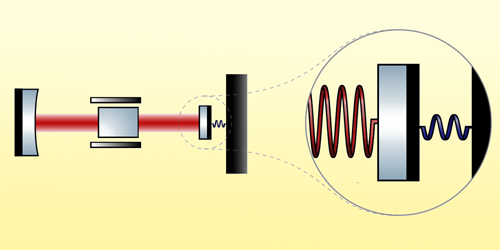• Physics 17, s40
Adding a nonlinear crystal to an optical spring can change the spring’s stiffness, a finding that could allow the use of such devices as gravitational-wave detectors.
Systems as disparate as atoms in crystal lattices and components of oscillating electrical circuits can be modeled as masses on springs. Sometimes the analogy is so apt that a function usually performed by a spring is performed by a completely different system. One example is an optical spring—a displacement-measuring device—in which the “spring” is an optical cavity. Now Sotatsu Otabe at the Tokyo Institute of Technology and his colleagues have made an optical spring more sensitive to high-frequency perturbations by placing a nonlinear optical material inside the cavity [1].
The two walls of the team’s cavity are made of mirrors, one of which is movable. A mechanical spring fixed to the back of this mirror opposes the mirror’s motion in one direction. Radiation pressure from the light in the cavity resists the motion in the other direction. When the system is undisturbed, the cavity’s length is off resonant for the trapped light. When a perturbation displaces the moveable mirror such that the cavity shortens, the trapped light becomes resonant. The radiation pressure on the moveable mirror therefore increases, pushing the moveable mirror back toward its original position.
Optical-spring-based devices are so sensitive to changes in cavity length that they could be useful in future gravitational-wave detectors, particularly if the optical-spring constant could be increased. With a stiffer spring, the device would have a higher sensitivity to gravitational waves with frequencies beyond the range detectable by current observatories. Otabe and his colleagues stiffened their optical spring by placing inside the cavity a nonlinear crystal whose refractive index depended on the amplitude of light passing through it. This change introduced a nonlinearity in the relationship between the cavity length and radiation pressure, exaggerating the effect of mirror displacements and increasing the optical-spring constant 1.6-fold.
–Marric Stephens
Marric Stephens is a Corresponding Editor for Physics Magazine based in Bristol, UK.
References
- S. Otabe et al., “Kerr-enhanced optical spring,” Phys. Rev. Lett. 132, 143602 (2024).



